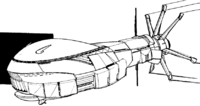Olympus
- This article is about the recharge station. For other uses, see Olympus (disambiguation).

| |
| Olympus | |
| Production information | |
| Manufacturer | |
| Type | Recharge Station |
| Tech Base | Star League |
| Cost | |
| Introduced | 2663[1] |
| Technical specifications | |
| Mass | 1,000,000 tons |
| Length | 660 meters |
| Width | 1,500 meters |
| Thrust | |
| Fuel (tons) | 10,000 |
| Fuel (days) | 39.52 |
| LF battery | Yes, 8 |
| Armament |
|
| Armor | 149 tons standard |
| Structural Integrity | 1 |
| Docking Collars | 4 |
| Crew/Passengers | 309
First-Class Passengers: 126 |
| Grav Decks | 2 (1 x 1,230 meters and 1 x 150 meters diameter) |
| Escape Pods/Life Boats | 50/15 |
| Heat Sinks | 200 single |
| BV (1.0) | 11,066[1][2] |
| BV (2.0) | |
Contents
Description[edit]
Many jump points in important star systems are home to so-called Recharge Stations, of which the Olympus is the largest and most well-known. These stations feature huge solar sails and can store vast amounts of energy, which they can transfer to waiting JumpShips by cable connection or by emission of microwaves, significantly shortening the recharge time due to concentrated energy flow. Apart from that, recharge stations also function as cargo stations and fuel bunkers for DropShips, and many of them form the core of orbital sensor and defense systems. Recharge stations are rarely subjected to a direct assault, because even during the Succession Wars, they were deemed too valuable to be damaged. However, they have been targeted by black-ops attacks in order to take out the sensor network they control prior to a planetary assault. In the days of the Star League, there were hundreds of Olympus stations, one apiece for the zenith and nadir jump points of every important system in the Inner Sphere, and the majority of the less important systems as well. But between the sabotage of sensors, age, and mechanical failure or human error, many were lost.[2][3]
Weighing in at about 1 million tons and having a 4,215-meter diameter sail, the Olympus features eight batteries, each one capable of recharging one JumpShip at a time. The most interesting feature is perhaps the inclusion of two repair docks each able to cope with ships up to 50,000 tons and a single, large dock for ships weighing up to 150,000 tons. These repair facilities are almost constantly occupied due to their popularity and acquiring a place can require booking six months in advance.[2][3]
The two grav decks are quite unique: one is "small", with a diameter of 150 meters, which holds the command section of the Olympus, while the other is the largest grav deck known to exist with a diameter of 1,230 meters. The larger grav deck holds all passenger and staff facilities, making duty aboard the station pleasant.[2][3]
Weapons and Equipment[edit]
The armament of the Olympus is geared toward anti-fighter defense. Each firing arc boosts the same configuration, erasing any blind spots in its defense. PPCs, LRM-20s, and Autocannon/20s provide each arc's main firepower, supplemented by lasers and short-range missile systems. The armor is somewhat weak, but as recharge stations are rarely the subject of a massed assault, it is deemed enough to protect the Olympus.[2][3]
Cargo[edit]
The Olympus can keep almost 12,500 tons of cargo in each of its 12 holds. The station can support six Small Craft as well as six aerospace fighters and sports four docking collars, making it a vital center for any incoming cargo ships. Apart from the crew, the Olympus also has quarters for 126 passengers. The stations are usually equipped with sufficient rescue equipment for all embarked personnel in case of an emergency.[2]
- Bay 1: Small Craft (6), 2 doors
- Bay 2: Aerospace Fighters (6), 2 doors
- Bay 3: Pressurized Repair Facility (50,000 tons capacity)
- Bay 4: Pressurized Repair Facility (50,000 tons capacity)
- Bay 5: Pressurized Repair Facilities (150,000 tons capacity)
- Bay 6: Cargo (144,999 tons), 12 doors
Variants[edit]
No official variants seem to exist, but some of the many stations in use have been customized over the years of their existence.
Named Stations[edit]
(See List of named Olympus-class Space Stations)
Notes[edit]
- In German products, the unit's proper name was translated to Olymp.[4]
Gallery[edit]
Original Olympus from DropShips and JumpShips
Olympus from TRO:3057
Cutaway of Olympus from TechManual





